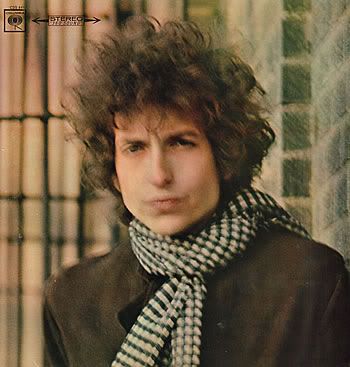
Artist: Bob Dylan
Album: Blonde On Blonde
Label: Columbia
Year: 1966
Blonde On Blonde. One of those Citizen Kane's or Einstein's of pop music, where its name alone, no matter the context, must be synonymous with greatness of some kind. As the first double-album in rock (a fact that I feel is often neglected, as this is pretty damn important--unless I'm missing a record which I don't think I am) it lays the foundation for what all great double-albums should be: diverse, yet focused. It touches on all the elements that had guided his career up to that point, and progresses it by doing so; by taking his songwriting quality to new heights. While so many double albums are bogged down by (among other things) a need for the artist to touch on any and everything in their songwriting abilities, Dylan wisely eschews this approach. So rather than a solo-folk song that reminisces his first four records, or any political approach, he does what even his greatest detractors couldn't deny: he continues his approach of always going forward with his music.
It's also important because it marks the end of his first era. Every year since 1961 had seen at least one new record that took a huge step for him. After the album's release, Dylan would be in a now legendary motorcycle accident, that led to his fleeing from the public life. Though he'd release his next album at the end of 1967, there is a world of difference between Blonde on Blonde and John Wesley Harding. It also features a new backing band, as Mike Bloomfield's definitive guitar work is replaced by Robbie Robertson and other members of The Hawks, who would go on to form The Band. The album was recorded over a period of two-weeks, and Dylan was known to have been editing snogs at the eleventh hour constantly, making adjustments right before the band was set to record. The creative tension that surely existed, as well as Dylan riding the tail end of a superb creative wave helps to create one of rock's most enduring masterpieces.
Though 1967-1969 are seen as the psychedelic years for pop music, some of the best pop music really precedes that era by a year. Dylan never really made any "psychedelic" music (thank God) but the lyrical imagery on this album is some of his most stolen. "Jules and binoculars hang from the head of the mules" he sings in "Visions of Johanna." The side-long epic "Sad-Eyed Lady of the Lowlands" is another high point in his lyrics, but the album gets personal in a way he barely had before. Lyrics from "Just Like A Woman" and "One Of Us Must Know (Sooner Or Later)" allow one to suspect that there is a single person these songs could be inspired by--not just Dylan's generally poetic nature. But musically, this is an even greater achievement than lyrically.
Dylan's first two electric albums were brilliant because they gave rock and roll a new voice. Not as poppy as The Beatles or blues-y as The Stones, Highway 61 Revisited and Bringing It All Back Home seemed like a follow-up album to a Chuck Berry record more than anything else. And at the time, the mid-1960s, with the fallout of the first era of rock and rollers (Little Richard, Jerry Lee Lewis, Buddy Holly), that stuff wasn't exactly in vogue. But on Blonde on Blonde, Dylan goes beyond that template, borrowing more from the blues ("Leopard-Skin Pill-Box Hat" and "Pledging My Time") and New Orleans brass ("Rainy Day Women #12 and 35"). Beyond that, the songs no longer have that "boogie" feel, which both his slow and fast numbers really did. Instead, there's actually a return to a folkier vibe, but the rock and roll, full band instrumentation gives it new life. Think about the repetitive nature of the lyrics on Bringing It All Back Home: "I ain't going to work on Maggie's farm no more" is how each lyric begins. But here, on Blonde, the song structure is much folkier. When he does get into the boogie woogie, on the penultimate track "Obviously 5 Believers" it's brief, to the point, and still fits in with the sprawling record.
I don't know if I've made a point...or ever make a point for that matter. Blonde on Blonde is still the first and one of the best double albums ever. Afterwards, Dylan and pop music would really never be the same again. That may be more of a correlation than anything else, but it's still an important marking point. If you have any doubt about the album's greatness, think about the scene in High Fidelity (the movie) where Jack Black's character exclaims, "You don't own Blonde on Blonde!?" Try to substitute a different album title for Blonde, and see how effective it is.
No comments:
Post a Comment